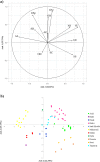Morphological characterization and genetic diversity analysis of Tunisian durum wheat (Triticum turgidum var. durum) accessions
- PMID: 33568058
- PMCID: PMC7860204
- DOI: 10.1186/s12863-021-00958-3
Morphological characterization and genetic diversity analysis of Tunisian durum wheat (Triticum turgidum var. durum) accessions
Abstract
Background: Tunisia is considered a secondary center of diversification of durum wheat and has a large number of abandoned old local landraces. An accurate investigation and characterization of the morphological and genetic features of these landraces would allow their rehabilitation and utilization in wheat breeding programs. Here, we investigated a diverse collection of 304 local accessions of durum wheat collected from five regions and three climate stages of central and southern Tunisia.
Results: Durum wheat accessions were morphologically characterized using 12 spike- and grain-related traits. A mean Shannon-Weaver index (H') of 0.80 was obtained, indicating high level of polymorphism among accessions. Based on these traits, 11 local landraces including Mahmoudi, Azizi, Jneh Khotifa, Mekki, Biskri, Taganrog, Biada, Badri, Richi, Roussia and Souri were identified. Spike length (H' = 0.98), spike shape (H' = 0.86), grain size (H' = 0.94), grain shape (H' = 0.87) and grain color (H' = 0.86) were the most polymorphic morphological traits. The genetic diversity of these accessions was assessed using 10 simple sequence repeat (SSR) markers, with a polymorphic information content (PIC) of 0.69. Levels of genetic diversity were generally high (I = 0.62; He = 0.35). In addition, population structure analysis revealed 11 genetic groups, which were significantly correlated with the morphological characterization. Analysis of molecular variance (AMOVA) showed high genetic variation within regions (81%) and within genetic groups (41%), reflecting a considerable amount of admixture between landraces. The moderate (19%) and high (59%) levels of genetic variation detected among regions and among genetic groups, respectively, highlighted the selection practices of farmers. Furthermore, Mahmoudi accessions showed significant variation in spike density between central Tunisia (compact spikes) and southern Tunisia (loose spikes with open glume), may indicate an adaptation to high temperature in the south.
Conclusion: Overall, this study demonstrates the genetic richness of local durum wheat germplasm for better in situ and ex situ conservation and for the subsequent use of these accessions in wheat breeding programs.
Keywords: Durum wheat; Genetic diversity; Landrace characterization; Local landraces; Phenotypic diversity; Population structure.
Conflict of interest statement
The authors declare that they have no competing interests.
Figures




References
-
- Moragues M, Moralejo M, Sorrells ME, Royo C. Dispersal of durum wheat landraces across the Mediterranean basin assessed by AFLPs and microsatellites. Genet Resour Crop Evol. 2007;54:1133–1144. doi: 10.1007/s10722-006-9005-8. - DOI
-
- Kabbaj H, Sall AT, Al-Abdallat A, Geleta M, Amri A, Filali-Maltouf A, Belkadi B, Ortiz R, Bassi FM. Genetic diversity within a global panel of durum wheat (Triticum durum) landraces and modern germplasm reveals the history of alleles exchange. Front Plant Sci. 2017;8:1277. doi: 10.3389/fpls.2017.01277. - DOI - PMC - PubMed
-
- Feldman M. Origin of cultivated wheat. In: Bonjean AP, Angus WJ, editors. The world wheat book: a history of wheat breeding. Paris: Lavoisier; 2001. pp. 3–57.
-
- Royo C, Nazco R, Villegas D. The climate of the zone of origin of Mediterranean durum wheat (Triticum durum Desf.) landraces affects their agronomic performance. Genet Resour Crop Ev. 2014;61:1345–1358. doi: 10.1007/s10722-014-0116-3. - DOI
-
- Bonjean AP, Angus WJ, van Ginkel M. The world wheat book: a history of wheat breeding. Paris: Lavoisier; 2016. p. 3.
Publication types
MeSH terms
LinkOut - more resources
Full Text Sources
Other Literature Sources
